 In 2004, MI featured a gallery of portraits of Georgians from David W. Vaughan’s collection. In an accompanying interview, the Atlanta native shared his collecting origins and how he came to focus on Georgia portraits. Since then, examples from Vaughan’s collection have appeared in numerous publications and places—notably the 2013 Metropolitan Museum of Art exhibit Photography and the American Civil War. This gallery features highlights of his recent collecting journey.
In 2004, MI featured a gallery of portraits of Georgians from David W. Vaughan’s collection. In an accompanying interview, the Atlanta native shared his collecting origins and how he came to focus on Georgia portraits. Since then, examples from Vaughan’s collection have appeared in numerous publications and places—notably the 2013 Metropolitan Museum of Art exhibit Photography and the American Civil War. This gallery features highlights of his recent collecting journey.
We interviewed Vaughan to learn where his collecting journey has taken him and how his experiences have shaped his life.
Q: How did the experience of being published in MI sixteen years ago shape you as a collector?
The Georgia issue of Military Images introduced me to a lot of collectors and historians that knew very little about my collection. I also heard from a lot of readers that were amazed that I had so many Georgia images. Having all my Georgians published in one issue definitely helped brand me as “The Georgia Image guy” as well as help me acquire more images.
Q: In an interview for the 2004 issue, you stated, “To hold a Confederate image and look into the soldier’s eyes, see his uniform and accouterments, just as he was on the day it was taken, always gives me goose bumps.” Still true today? What else do you think about now that you might not have thought about then?
Definitely, and true today. This is why I still collect. I’ve been in awe of the Confederate soldier since hearing their stories when I was a kid. My focus has changed a little. I love identified images because I enjoy researching and learning about their individual history and how it was connected to the overall war.
Q: Much has happened in your collecting life since then—the 2013 Met Show certainly stands out. Talk about some of the other highlights.

The Metropolitan Museum of Art exhibition was over the top. The notoriety and national attention was incredible and it would be tough to surpass. It certainly opened a lot of doors. My collection has also been prominently featured in five Georgia-based museums, as well as being published in prominent books and publications like The Met’s book, Photography And The American Civil War, National Geographic books, Time-Life books, Arkansas Press’ – Portraits of Conflict series, Mercer Press, Garden & Gun, Georgia Backroads, The Magazine Antiques, and, of course, Military Images. With these channels of exposure, I have also appeared on the PBS series History Detectives and was asked to serve on the Board of the University of Georgia Library and the Atlanta Preservation Center.
Q: How has your collecting and your collection changed or not changed since the mid-2000s?
I’ve learned to be patient. I may only add two or three prominent images a year. I’m okay with that. When I first started out, I bought everything I could afford. But now I’d rather have some of the best Confederate images than the largest collection.
Q: Since then, collecting has changed due to the maturing of the internet, in particular social media. Pros and cons?
The internet quickly changed collecting. Before the internet, I had a network of collectors and dealers across the country that would contact me if they came across a quality Confederate image. This network pretty much kept me in the poor house as I was frequently buying another image before I had paid off the last one I purchased. The internet quickly replaced my network. Now, it’s so easy for a family member or a dealer to list an image on eBay or another auction site and sell to the highest bidder. The internet’s influence undercuts the old style of networking.
Q: A new generation of caretakers are involved in collecting and preserving Civil War portrait photography. What advice do you have for them?
Don’t collect in a vacuum. Network with collectors and scholars. It’s amazing how much you can learn from someone that has 20-plus years of experience. I owe a great deal of gratitude to some of the pioneers in image collecting: Larry Jones, Bill Turner, Herb Peck and George Whiteley as well as others that gave me great advice and coaching when I first started out. It’s also important to share what you have with others. As collectors, we build upon the collective knowledge of each other. We know a great deal more today about the photographs and the photographers than we knew 30 years ago. I have always felt that I am only the caretaker of these images and as a result, I frequently allow authors, publishers, collectors and researchers to reproduce them in a positive way.
Q: What’s next for your collection?
That’s a great question. I haven’t quite figured out the scenario moving forward. If they go to an institution, I’d like to see all my Georgia images and the core of my collection stay together. It would be very difficult and exponentially more expensive to recreate the Georgia grouping.
Q: Anything else you’d like MI to know?
I have been fortunate enough to transition my passion and collecting endeavors to a full-time business—Vaughan Estate Sales & Appraisals—which focuses on residential real estate, estate sales, and fine art and antiques appraisal services. I recently joined Ansley Atlanta Real Estate. One passion leads to another and I’m very excited about this chapter in my life.
Representative images
Fearsome Four of Company K
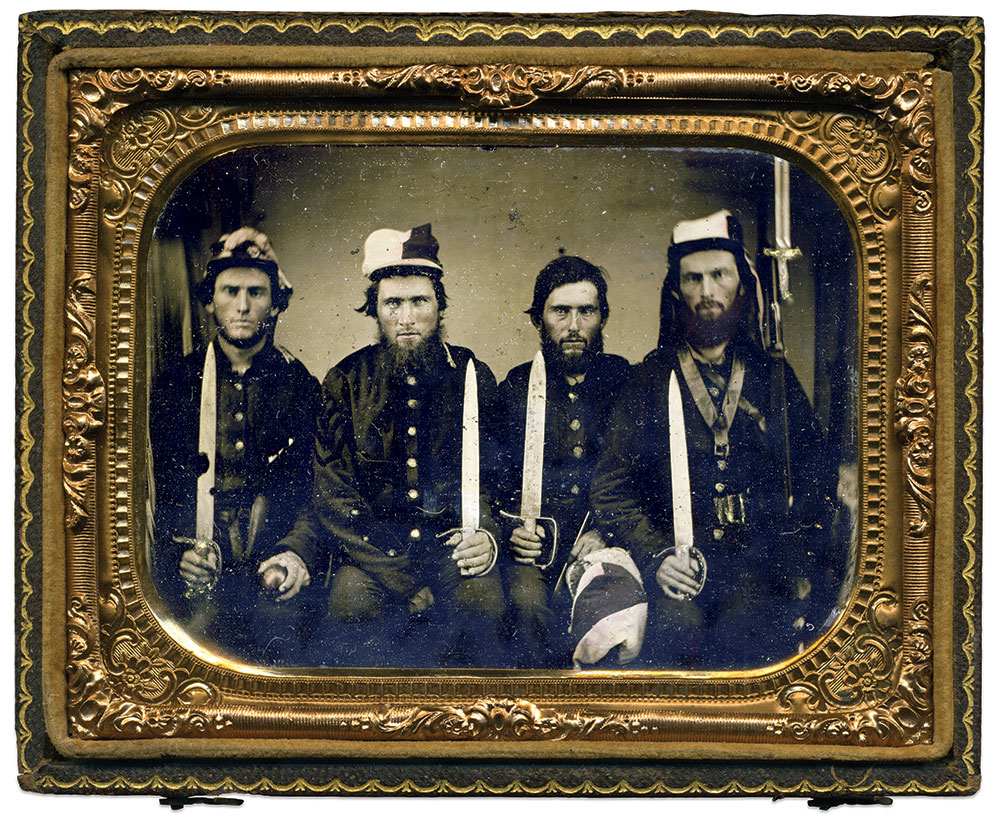
Sometime before July 1862, the Pattillo brothers of Henry County posed for this portrait. Seated, from left to right, are Benjamin Franklin, Jr., George McIntosh Troup, James Martin, and John Reeve Jeter Pattillo.
John, the youngest, enlisted first. In August 1861, he joined the Henry Volunteers, which became Company K of the state’s 23rd Infantry and served under Gen. A.P. Hill. He suffered a wound at the Battle of Seven Pines, Va., during the fighting on the Peninsula on May 31, 1862. Though the nature of his wound went unreported, it resulted in a two-week hospital stay. He returned to the hospital five months later suffering effects from his wound, and received a discharge in March 1863.
Two of John’s older brothers, George and James, followed him into Company K about a month later. Both served through the war. George was uninjured. James received a wound in August 1864 at Deep Bottom, Va.
Benjamin, the last brother to join the company, enlisted in July 1862. About a month later, he was killed during the Second Battle of Manassas.
The Pattillo boys are pictured here with imposing D-Guard, spear point knives. Benjamin, far left, holds a rare example of a Confederate hand grenade. George, second from left, wears a uniform blouse with unusual sleeve trim with three decorative buttons. James, third from left, grasps a D-guard knife with a slightly different hilt configuration. John, far right, sports a Corsican cover over his cap. He holds a Model 1855 brass mounted, two-band rifle with a fixed saber bayonet, and wears a rifleman’s belt.
After the war, the three surviving brothers lived out their lives in the South. James was the first to die in 1908. He was in his early 70s. George died the following year at 76. Both are buried in Georgia. The last and youngest, John, died in Alabama in 1928 at age 89.
Bowie and Colt

A soldier brandishing a Bowie knife and a .36 caliber Model 1851 Colt Navy revolver poses with his distinctive dark-trimmed uniform and broad-brimmed hat. The image was discovered in Juliette, Ga., located along the Ocmulgee River between Atlanta and Macon.
A Sumter Light Guardsman
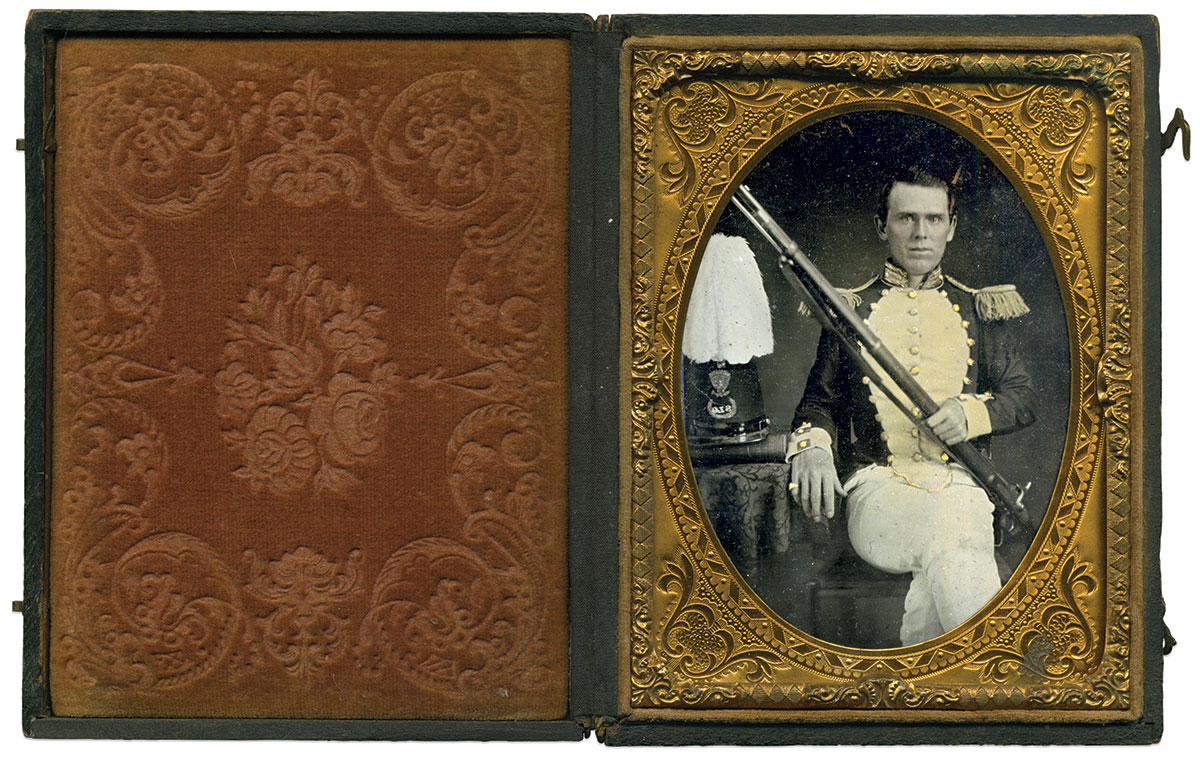
An unidentified militiaman of the Sumter Light Guards sat for this portrait sometime in 1861, garbed in the full military dress of his company. He clutches his English Enfield Pattern 1853 rifled-musket with evident pride. His shako rests on the table beside him, revealing a Jeff Davis eagle emblem and the letters SLG wrapped in a decorative brass wreath.
The Guards formed in 1854 in Americus, Sumter County, Ga. At the start of the war, they traveled to Augusta, enlisted into Confederate service, and became Company K of the state’s 4th Infantry.
They did not remain in Augusta long. Within three days of their enlistment, the regiment moved north to secure the Navy Yard in Portsmouth, Va.—the first Georgia unit to cross into Virginia during the war. The 4th was soon assigned to the Army of Northern Virginia and remained with it until the final surrender at Appomattox Court House in 1865.
The Pride of Augusta

A militia unit dating to 1854, the Washington Artillery of Augusta, Ga., was expertly led, skillfully trained and fully armed and equipped. These characteristics distinguished it from the majority of other, more social organizations formed during the pre-war period.
In April 1861, it operated as an independent company of six guns. Ordered to duty in Pensacola, Fla., it became one of the first field batteries in the Confederacy. The artillerymen served in varied commands throughout the war, ultimately spending most of its enlistment with the Army of Tennessee. In late 1863, following the Battle of Missionary Ridge, it was detached from the army and ordered to the defenses of Atlanta. Here, in early 1864, the company converted to heavy artillery. In the summer, the company moved to Savannah and participated in defensive operations until the city fell to Union forces in December 1864. Afterwards, the company rejoined the Army of Tennessee and participated in the Carolinas Campaign as infantry. It remained as such until the war’s end.
Taken sometime in 1861, this portrait features a young artilleryman wearing gray trousers and a 7-button frock coat with red collar and cuffs. He sports a dark-colored forage cap and hat brass exhibiting WA pinned above a Confederate first national flag.
An Upson Guardsman
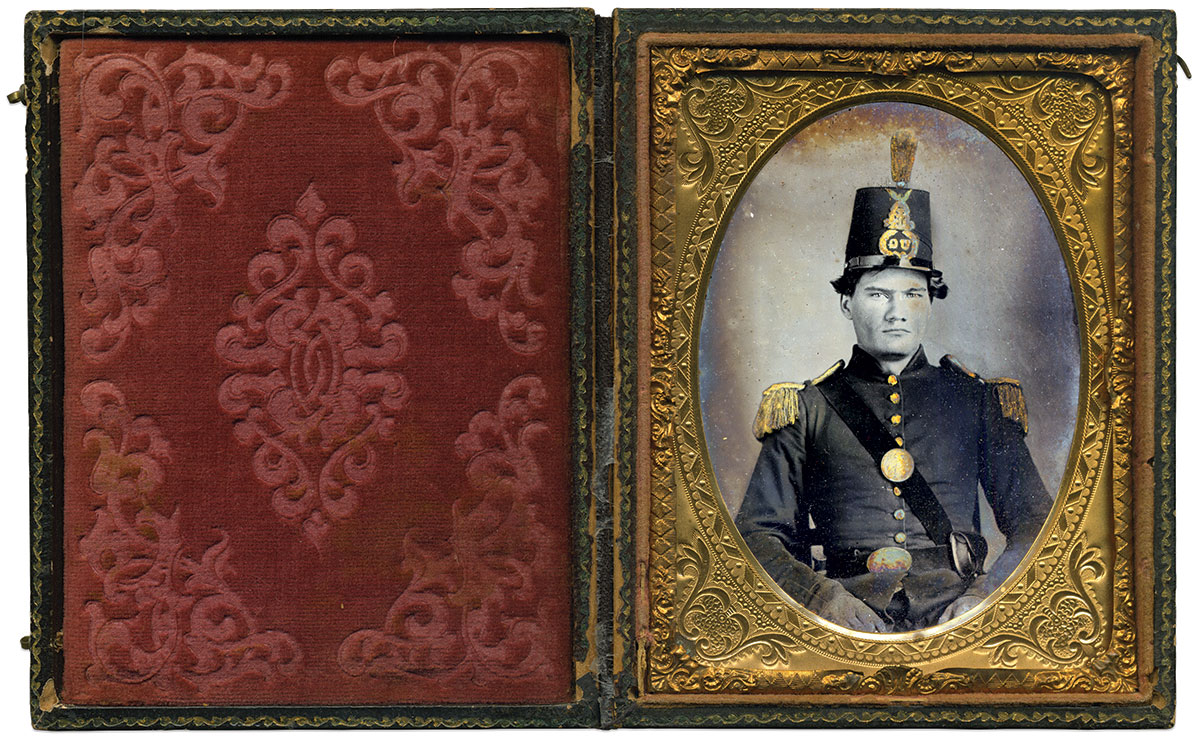
Sometime in 1861 this unidentified member of the Upson Guards, a militia unit formed in the west central part of the state in Upson County, posed in its uniform: A dark blue 9-button frock coat, belt buckle and hat brass featuring the Georgia state seal, and the letters UG on his headgear topped with a pompom.
Organized in 1859 by State Militia Gen. Thomas Beall, the Guards mustered into the 5th Georgia Infantry in May 1861. The regiment served mostly with the Army of Tennessee, notably at the 1862 Battle of Murfreesboro, where it suffered a casualty rate of upwards of 35 percent. The following year at the Battle of Chickamauga, it sustained a 55 percent loss, among the highest on both sides of the fighting. The fate of this soldier is unknown.
The 5th surrendered with Lt. Gen. Joseph E. Johnston’s Army of Tennessee at Bentonville, N.C., in April 1865.
“Charge Again!”

Organized as an Independent Rifle Corps of militia in Augusta in the early 1850s, the Clinch Rifles were originally composed of local firemen from the Clinch Engine Company No. 2. The company took its name from Col. Duncan L. Clinch, a veteran of the Seminole Wars. He was known as the “Spartan General” for simple living while on campaign. The Clinch Rifles adopted the motto “Charge Again!” which was derived from an order given by Gen. Clinch during a successful attack during his war service.
The Clinch Rifles were celebrated as one of the most organized, best drilled and handsomely outfitted militia companies in Georgia. The men wore privately made uniforms purchased by its members. They were styled after European infantry, constructed with green cloth, trimmed in gold braid and gold buttons and topped with a French-style cap. The men also armed and equipped themselves with 1841 Mississippi Rifles and saber bayonets.
After the Civil War began, the Clinch Rifles became Company A of the 5th Georgia Infantry, and saw service primarily in the Western Theater. The regiment engaged in numerous battles, including Stones River, where it suffered over 50 percent casualties and the loss of their colors.
The survivors of the Clinch Rifles and the rest of their comrades were surrendered at Durham Station, N.C., on April 26, 1865.
An Officer and an Entrepreneur
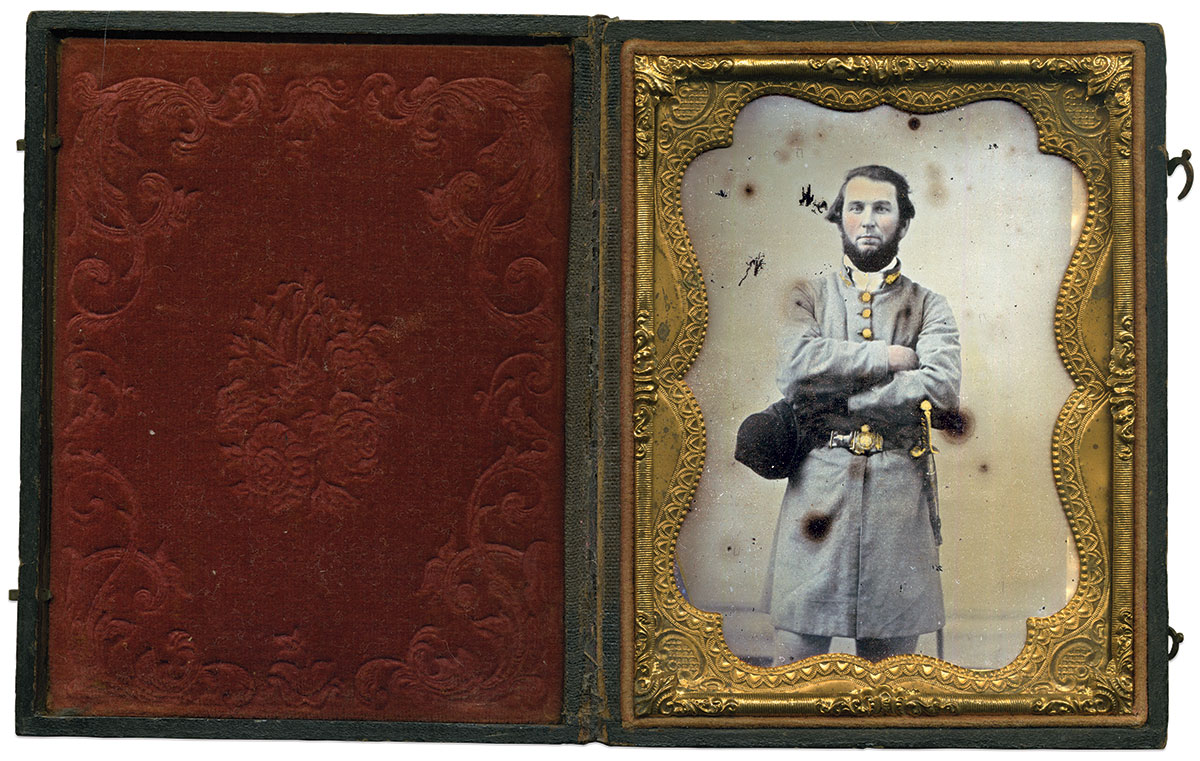
James Smith Allums stands with arms crossed in a blue-gray tinted frock coat with a dark colored cap in hand. An officer’s sword hangs from his belt, which is fastened by a two-piece buckle that features the Georgia state seal.
Allums, a prosperous businessman in the west central Georgia town of Cusseta, loaned funds to his home county of Chattahoochee to uniform and equip Georgians after the Civil War began. In November 1861, he became second lieutenant of Company G of the 31st Georgia Infantry. Six months later, the Confederate army reorganized, and Company G elected officers, Allums did not get the votes. This may suggest that, though an accomplished business leader he may have been limited in his abilities as an officer.
Allums resigned and returned home to his family and business. He remained active in the military as captain of Company I of the 5th Georgia State Guards, also known as the Chattahoochee Guards or Allums Company. He later served as a first lieutenant in the 6th Georgia Militia.
In 1866, he received a patent for a cotton or hay press. It was his second—he had received his first patent in 1861 for a cotton press.
Allums died in 1872 at age 48. His wife, Mary Elizabeth, and six children survived him.
With Georgia, For Better or For Worse
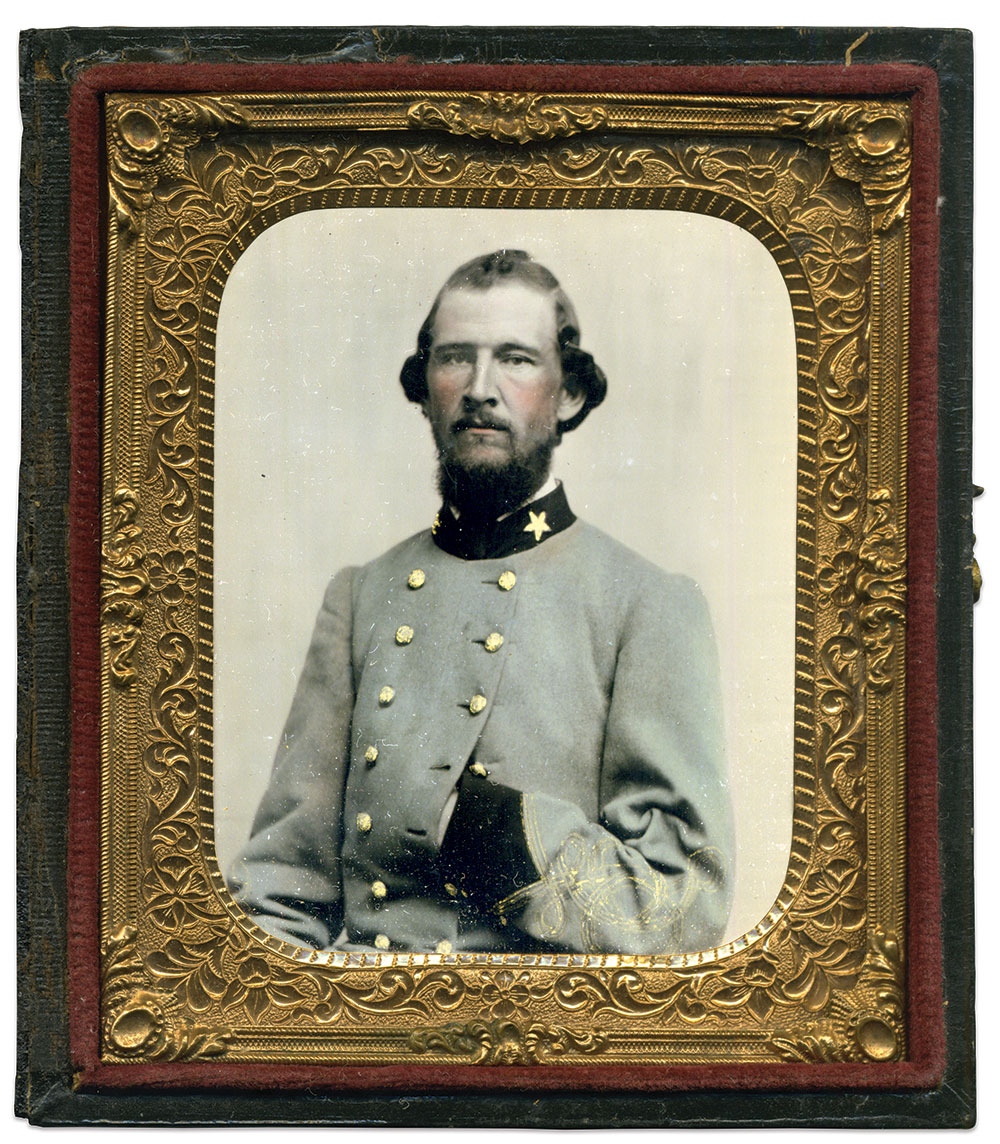
Not all those who lived below the Mason-Dixon line during the antebellum years favored secession. But when Georgia voted to secede, many of her pro-Unionist sons picked up the sword and gun in her defense. Case in point: the North Georgia man featured in this portrait, Dr. Elijah Fletcher Starr. A prominent pro-Union legislator and signer of the Georgia Ordinance of Secession, he lived in Nacoochee, White County, when the war began.
When hostilities broke out, he practiced medicine and raised a family of 10 children with his wife. In June 1861, he received a first lieutenant’s commission and joined Company C of the state’s 24th Infantry. His value as a physician became evident soon afterwards when, in September 1861, he was appointed assistant surgeon. He advanced to full surgeon in June 1863.
He tended to the needs of his soldier-patients throughout the regiment’s numerous engagements with the Army of Northern Virginia, from the 1862 Peninsula Campaign to operations around Petersburg in 1864. Ill health that plagued him for much of his service prompted him to resign his commission in October 1864.
Starr returned to his family and practice in Nacoochee. He died in 1898 at age 78.
Stalwart Trooper
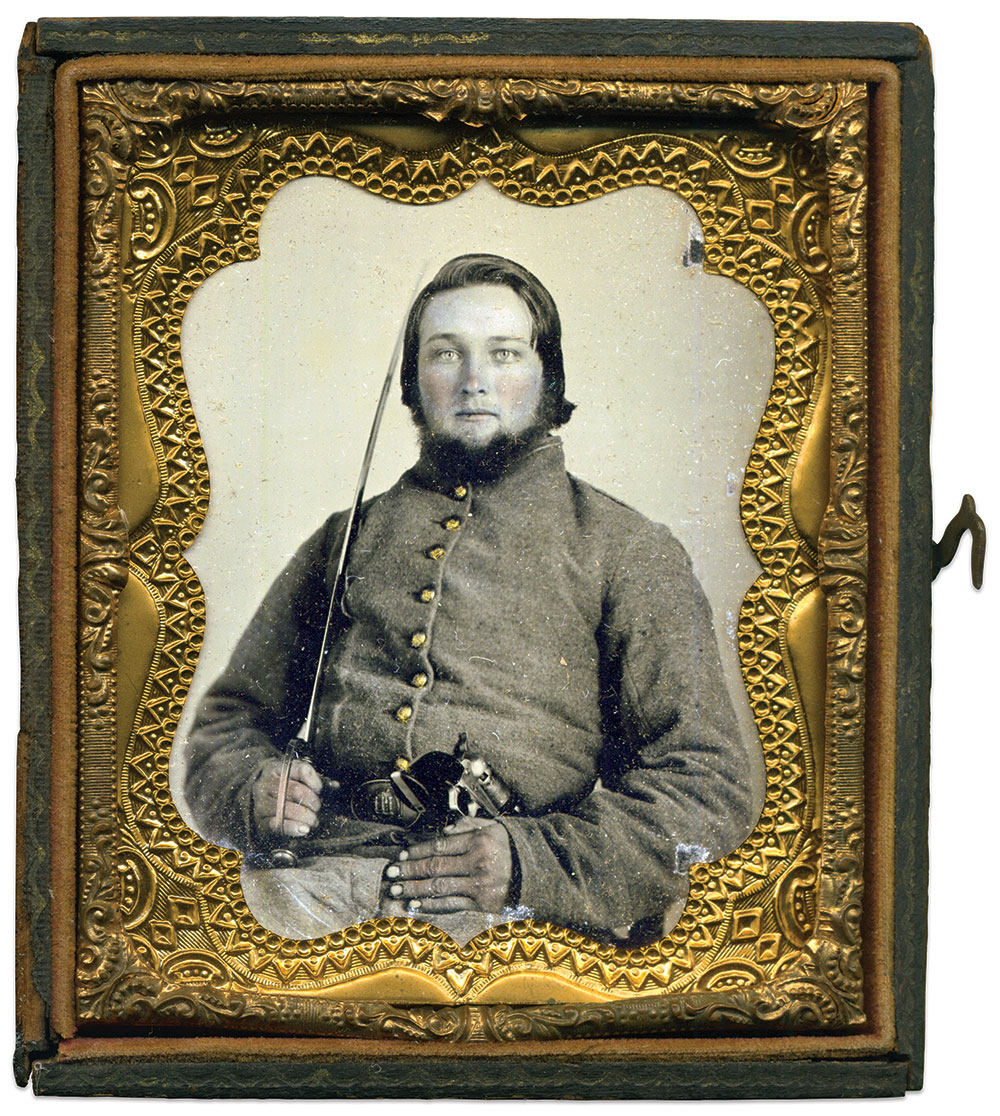
One of three brothers to fight for Georgia and the Confederacy, 20-year-old Alfred Webb Cantrell enlisted in the Georgia Troopers in February 1862. Designated Company H of Cobb’s Legion, he and his comrades became part of the Army of Northern Virginia, and participated in campaigns and battles from the Seven Days to Cold Harbor. Cantrell represents the stalwart cavalryman who remained in the saddle for the duration, fighting without distinction through the end of the war. After his parole at Greensboro, N.C., on May 1, 1865, he returned to Georgia briefly, and then relocated to Missouri, where he lived out his days as a farmer. He died in 1917 at age 75.
A Stephens Home Guardsman
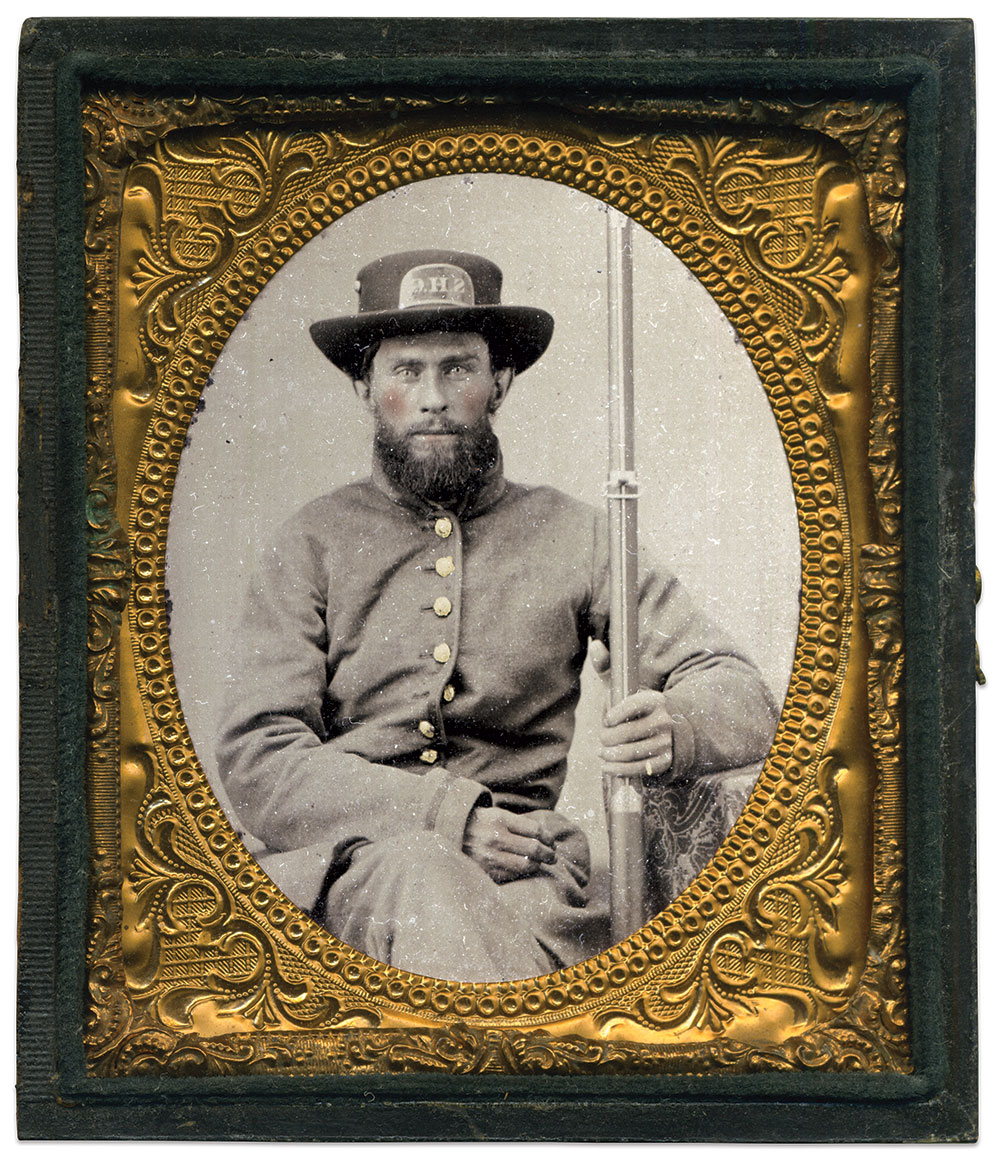
After Fort Sumter fell in April 1861, the first company to organize in Crawfordville, Ga., was the Stephens Home Guards. The company took its name for the town’s best-known resident, Confederate Vice President Alexander Stephens.
The company was armed with weapons produced by a local gunsmith, Henning Daniel Murden, in nearby Robinson. Murden, the grandson of a Continental Army soldier who fought in the Revolutionary War, had a son and two nephews in the Stephens Home Guards.
In July 1861, the Guards mustered into Confederate service as Company D of the 15th Georgia Infantry. This regiment moved to Virginia and was assigned to Toombs’s-Benning’s Brigade and attached to the Army of Northern Virginia. The 15th served throughout the war and surrendered at Appomattox Court House in April 1865.
Discovered in the Moore Estate within the parsonage of the First Presbyterian Church in Greensboro, Ga., this portrait depicts a seated private wearing a wide brimmed hat with hat brass bearing the initials SHG. He sports gray trousers and a matching frock coat with narrow dark trim on the collar and cuffs. His gun is not a Murden.
Devoted Youth
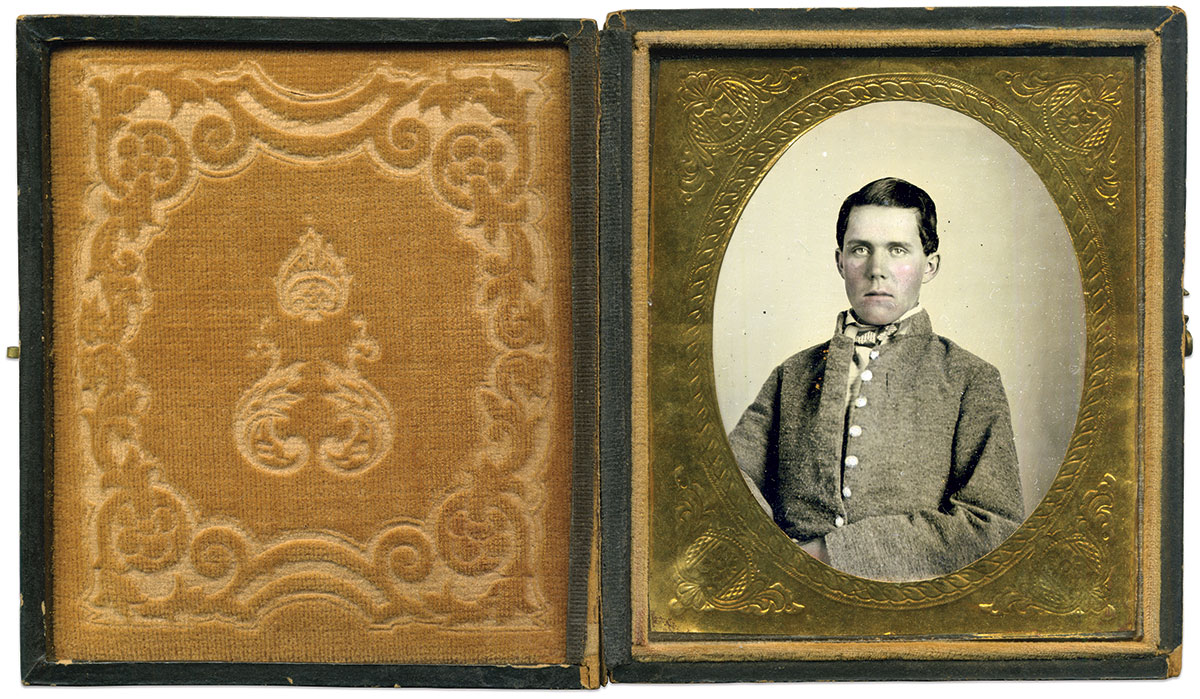
In September 1861 at the tender age of 15, Lucas Haynes Lampkin of Athens enrolled in the Mell Rifles, a local militia company raised by Baptist minister and University of Georgia Chancellor Patrick Mell. Soon afterwards, the company traveled by rail to Richmond, Va., where it joined Col. Thomas R.R. Cobb’s Legion of Georgia Volunteers.
Lampkin served throughout the war, from the Peninsula Campaign to the final surrender in 1865. At the war’s end, he was paroled at Greensboro, N.C., and made his way back to Georgia.Through all the battles and campaigns, he managed to avoid injury.
Having given up his youth to defend his home, he barely survived his enlistment. In 1866, Lampkin succumbed to meningitis at age 21. He was a student at the University of Georgia at the time of his death.
Raiding With Morgan
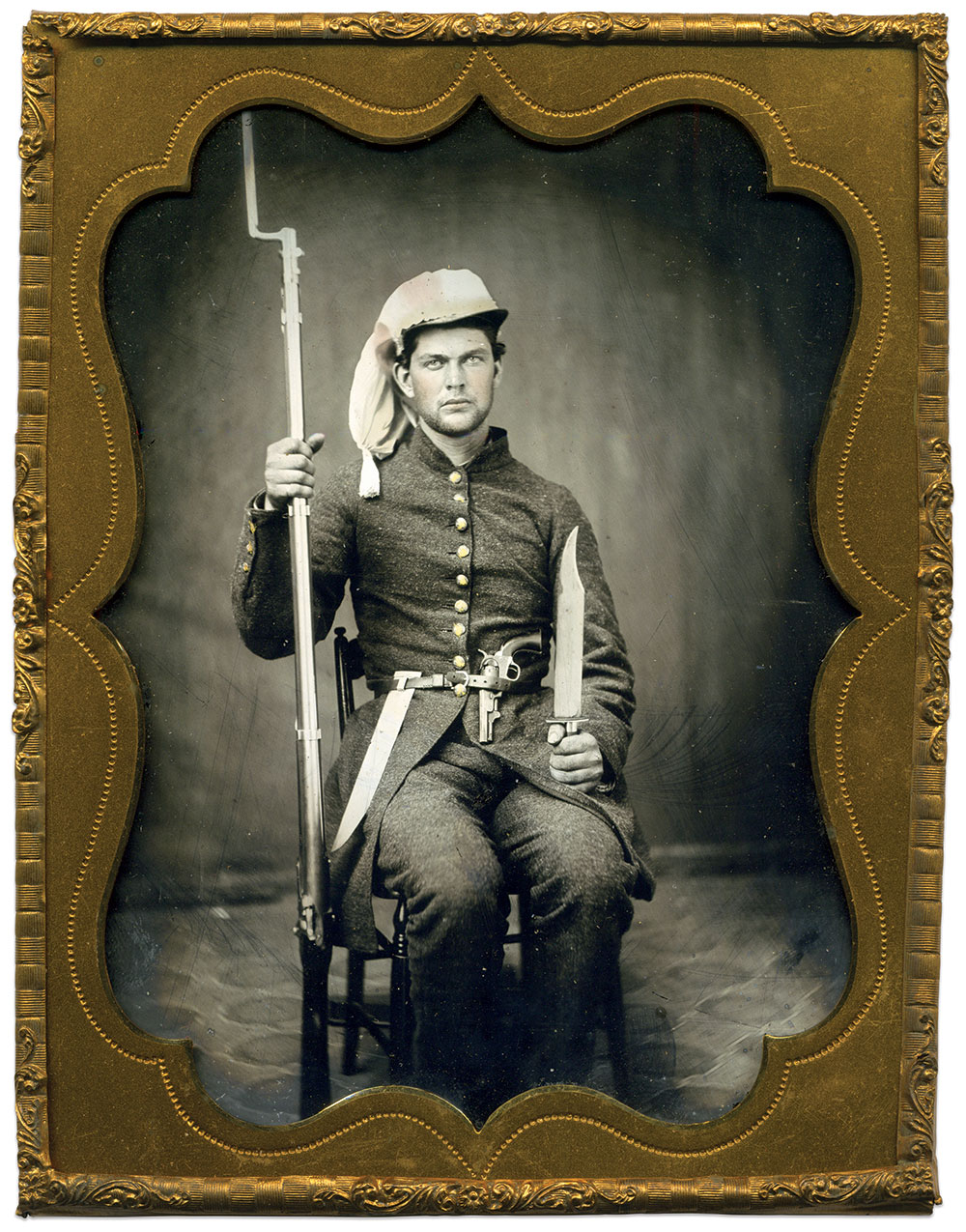
In early 1862, William Houston House, a 23-year-old native of Statham, a community outside Athens, enrolled in the local Jackson County Cavalry. Together with his older brother, James Lawrence House, he and the rest of the company mustered into Confederate service as Company E of the 16th Battalion, Georgia Partisan Rangers.
The battalion first served under Gen. John Hunt Morgan, who led the Georgians and the rest of his command on his first raid into Kentucky. Operating primarily in east Tennessee and western Virginia, it fought in many engagements and various skirmishes. In one action, at Knoxville, Tenn., in November 1862, James was killed.
By early 1865, the battalion’s size increased to 10 companies from seven, and its designation changed to the 13th Georgia Cavalry. House ended his service as sergeant when the regiment surrendered at Hillsboro, N.C. He received a parole, returned to his Jackson County farm, and reunited with his wife, Rebecca. They raised five children. House died in 1917 at age 77.
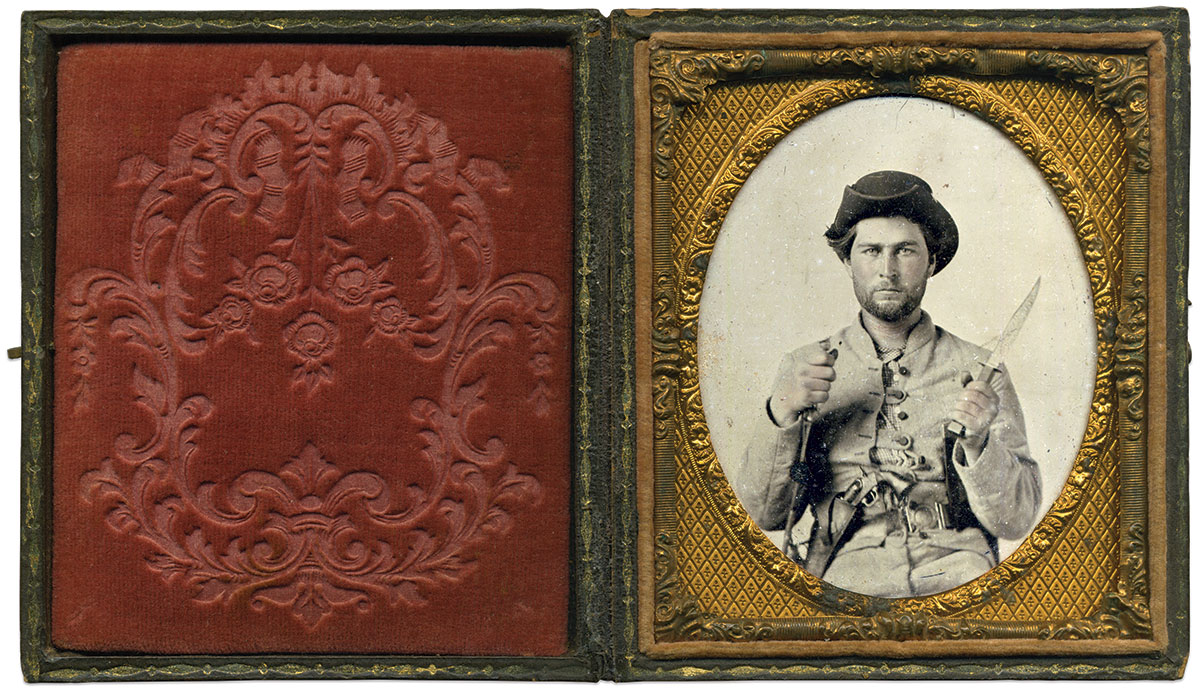
Escorting Cheatham

Farmer Thomas Mickleberry Merrett, seated to the left of an unidentified comrade in this portrait, traded his pitchfork for a saber after hostilities erupted in 1861 and enrolled in Capt. Thomas H. Jordan’s Georgia Dragoons. He and his fellow Dragoons became Company G of the 2nd Georgia Cavalry. Merrett served as first lieutenant.
The 2nd saw its first action under the command of Nathan Bedford Forrest in the summer of 1862, and by fall had participated in various skirmishes with Gen. Braxton Bragg’s army during the Kentucky Campaign. Assigned as cavalry escort for Maj. Gen. Benjamin F. Cheatham in September 1862, Company G served in this capacity until 1865.
Merrett became company commander after Capt. Jordan was killed in August 1863. Merrett served in this capacity until the regiment surrendered near Salisbury, N.C., on May 1, 1865.
Merrett returned to Marion County, and soon relocated to Americus, Ga., where he farmed until his death in 1892 at age 56.
Fighting with the Tom Cobb Infantry
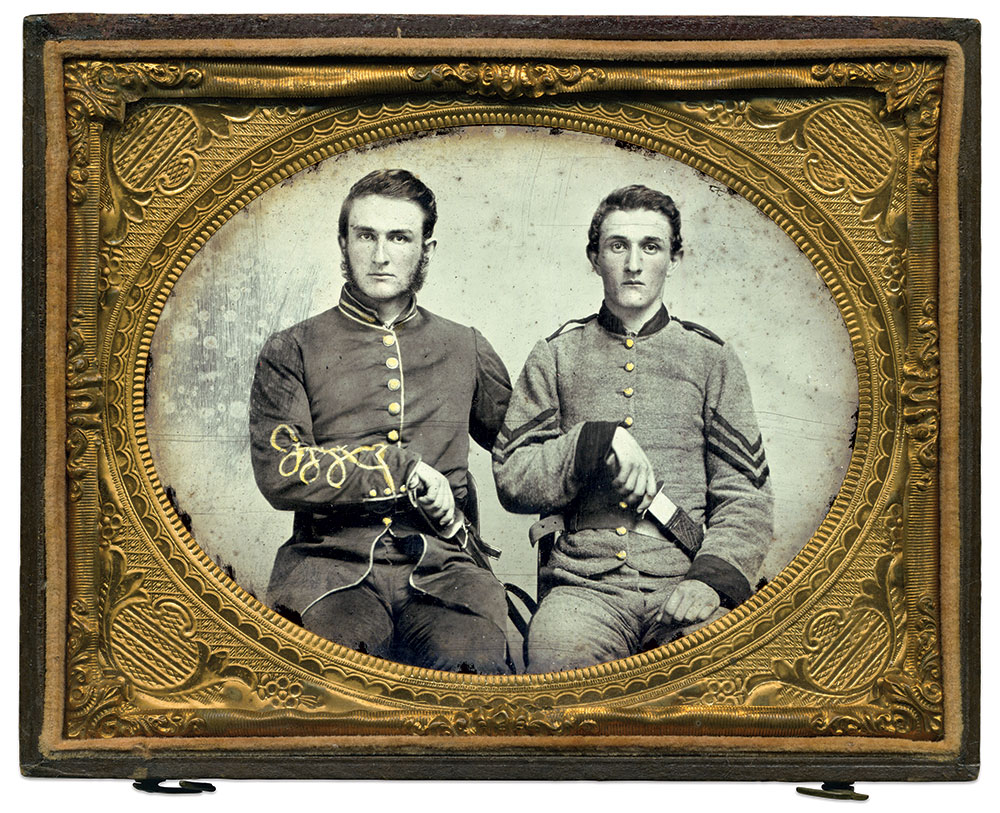
The Hawkins brothers, Charles Alexander and John Milner, enrolled in September 1861 in the Tom Cobb Legion, a local company from Oglethorpe County in northeast Georgia. It eventually became Company E of the state’s 38th Infantry. The rank and file elected Charles second lieutenant, and John received an appointment as second sergeant. This portrait reflects their ranks at the time of enlistment. Charles, seated on the left, displays his lieutenant’s stripes on his collar and officer’s braid on his cuffs. John wears his sergeant’s stripes. Both men are drawing their edged weapons.
The 38th spent the majority of its service with the Army of Northern Virginia.
During the 1862 Peninsula Campaign, John suffered a wound at the Battle of Gaines’ Mill. Sent home to recover from his injury, he served as an enrolling officer during his recuperation. John rejoined the regiment in late 1864, and was with it when he surrendered at Appomattox Court House in April 1865. He returned to Georgia with a parole and became a teacher. He died at age 86 in 1929.
Charles was less fortunate. Promoted to captain, he suffered wounds at the battles of Second Manassas and Antietam. After his second injury, he received a furlough to visit home, where he married Hortense McLester. The honeymoon was brief. Charles returned to his regiment and fought at Fredericksburg, during which he was wounded a third time, and also cited for gallantry.
Charles continued on to participate in the Gettysburg Campaign, where he suffered a mortal wound at the Second Battle of Winchester on June 13, 1863. A gunshot wound felled him as he led his men in a charge against an artillery battery. He died the following day, and was buried at the nearby Stonewall Cemetery, in Winchester.
Sinister Minister
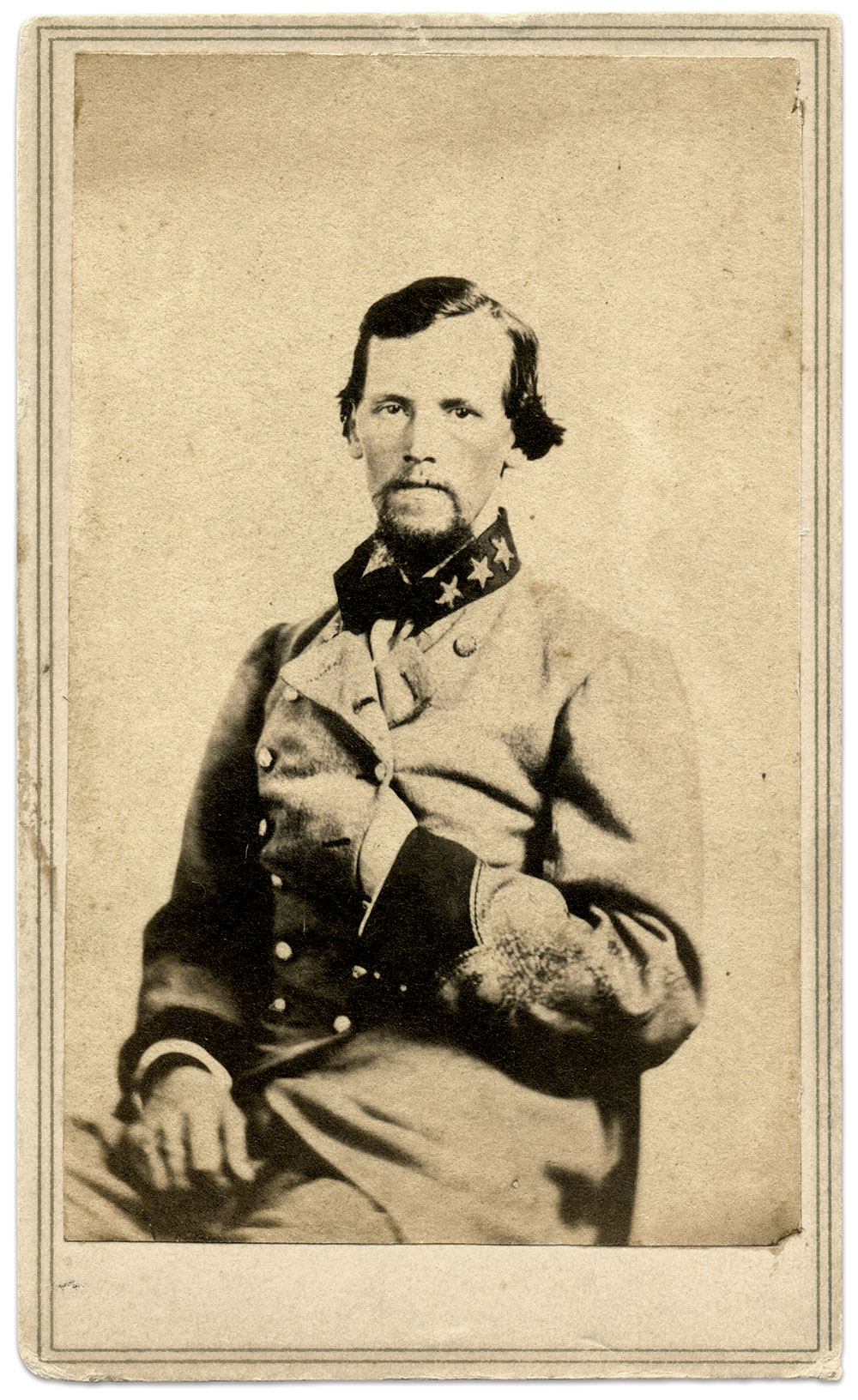
Shortly after his parole following the surrender in April 1865, Col. John R. Hart of the 6th Georgia Cavalry found himself under arrest by federal authorities. They slapped him in handcuffs and confined him in Fort Pulaski.
The charge: Permitting his men to murder a Union captain and a civilian.
A minister and farmer, the North Carolina-born Hart had moved to Georgia with his wife and children before the war. In June 1861, he raised a company of soldiers from his parish and it became Company E of the 21st Georgia Infantry. Each night after roll call, Hart required his men to kneel in prayer before dismissal. Though a man of the cloth, Hart loved hard liquor and single women. He reported sick one day and was ordered to the hospital. But he was observed staying at a nearby farmhouse. Turns out that Capt. Hart presented himself as a single man to the farmer’s daughter, to whom he proposed and became engaged. The ruse ended after the father discovered Hart’s scheme.
In 1862, Hart’s company was detached from the 21st and merged into Smith’s Georgia Legion. The men elected Hart lieutenant colonel. After the Legion dissolved in 1863, Hart became colonel of the new 6th Georgia Cavalry. In July 1864, he suffered a wound in the fighting around Atlanta.
Hart surrendered at the war’s end, and was then arrested for his role in the murders of two men. Union authorities eventually released him without further incident. Hart died in 1878 in Floyd County.
Left In Enemy Hands at Gettysburg

In September 1861, Alexander Wilks Vaughan joined the Goshen Blues, a company formed in Elbert County, Ga., and designated Company H of the 38th Georgia Infantry. The regiment left the state for Virginia and participated in a number of early engagements, first in the western part of the state, and later in the east.
Vaughan landed on the casualty list in two major battles. In 1862, he suffered a wound at Fredericksburg, the nature of which went unreported. At Gettysburg, he was wounded and left in enemy hands. Sent to DeCamp General Hospital in Davids Island in New York Harbor, he received a parole in September 1863. He appears to have spent the rest of the war in Georgia, and received a parole at Hartwell in May 1865. Vaughan spent the rest of his life as a farmer in Elbert County, dying in 1905 at age 67.
Lost on July 2

No one knows exactly where at Gettysburg Sgt. James Green Burton drew his last breath. The likely spots are the Triangular Field or Devil’s Den, where he and his comrades in the 2nd Georgia Infantry overran federals on July 2.
His loss deprived the Burton family of a beloved son and his home county of Burke a good soldier. In 1861, he had joined the Burke County Sharpshooters, which became Company D of the 2nd. After a few months along the Georgia coast, the 2nd moved to Virginia, joined the brigade of Gen. Robert Toombs, and served through the war’s end.
Burton suffered a wound at Antietam in an attempt to rescue the body of William R. Holmes, the regiment’s lieutenant colonel, from Burnside’s Bridge. Holmes, who had once served as the captain of Burton’s company, was killed trying to obtain more ammunition for his men. At some point that day, Burton and others were wounded in futile attempts to retrieve the remains.
Less than a year later at Gettysburg, Burton lost his life during the second day of fighting. No marked grave indicates his final resting place. He was in his early 20s.
Garden State Rebel
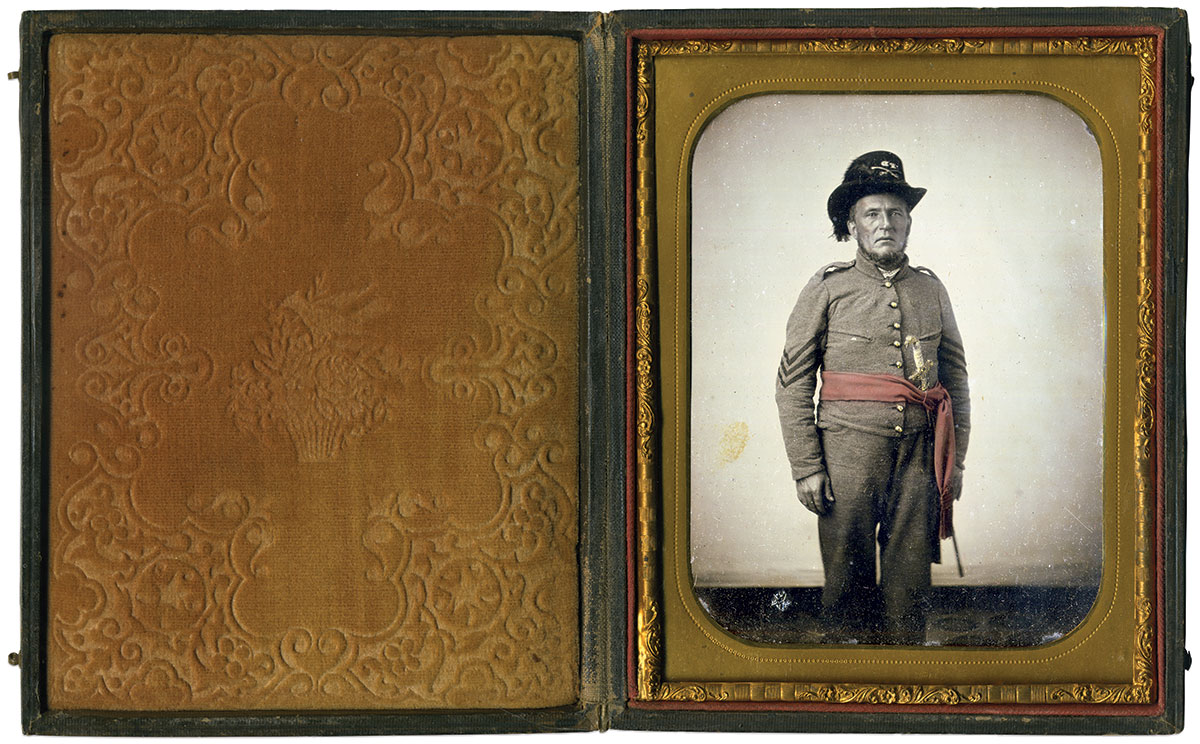
Sgt. Nathaniel Edward Gardner of the Fulton Dragoons of Atlanta posed for this portrait in 1861. His Southern enlistment and uniform belied his Northern origin. A New Jersey transplant, Gardner was a wealthy manufacturer of buggies and wagons in Atlanta when the war started. He chose to fight for his adopted city instead of the Garden State and the Union.
The Fulton Dragoons became Company B of Cobb’s Legion Cavalry. Gardner’s service was brief. Records indicate that he was sick and absent on furlough from the time of his enlistment in August 1861 until his discharge in February 1862.
He returned to service with local militia during Gen. William T. Sherman’s 1864 March to the Sea. He survived, returned to Atlanta, and died of cancer in 1878 at age 61.
In this portrait, Gardner wears a gray 8-button cavalry shell jacket with two breast pockets, widely spaced sergeant’s stripes, and shoulder epaulettes. A militia officer’s sword tucked into the red-tinted non-commissioned officers’ sash wraps around his waist. The sword may have been a photographer’s prop, or purchased before Gardner obtained a sword belt. An ostrich plume, crossed cavalry sabers and the letters FD adorn his Hardee-style hat.
Presidential Connection

Born and raised in Savannah, Edward Clifford Anderson, Jr., graduated from the University of Virginia in 1860. During his stay in Charlottesville, he met and married Jane Margaret Randolph—a great-granddaughter of Thomas Jefferson.
Anderson returned to Savannah with his bride and worked in banking until the political climate began to warm in late 1860. The following January, he enlisted as a private in a local militia company, the Georgia Hussars. He rose in rank to second lieutenant and left to become an aide-de-camp on the staff of his uncle, Brig. Gen. Hugh W. Mercer. In 1862, he traded his staff position for captain’s bars and raised a cavalry company, the Randolph Rangers. When it enlarged to battalion size, Anderson advanced to major. In early 1864, it became part of the 7th Georgia Cavalry. In early-June 1864, Anderson, now acting lieutenant colonel, and the regiment joined the Army of Northern Virginia. On June 11 at Trevilian Station, he suffered a disabling hip wound and fell into enemy hands. He escaped, received medical treatment, and convalesced with his in-laws, the Randolphs, in Charlottesville.
Anderson recovered and returned to Savannah in late 1864 on detached duty in command of about 200 irregular troops during the defense and evacuation of the city.
At the war’s end, Anderson gained his parole and returned to his family and business interests in banking and railroads. In 1876, he fell victim to a yellow fever outbreak at age 37.
GMI Cadet Officer

Resplendent in full dress, an unidentified cadet officer of the Georgia Military Institute posed for this portrait in the early 1860s. He wears the GMI winter uniform of gray wool triple-breasted, swallow-tailed coatee with shoulder epaulettes. His imposing dress officer’s shako with ostrich plume is adorned with hat brass depicting a flying eagle above the Georgia state seal. The shield device on his jacket may be a debating society pin.
GMI began operations in Marietta, Ga., in 1851. The Institute closely mirrored the United States Military Academy from its uniforms to its academics. But its routines were more rigid. After the Civil War began, the cadet corps broke from their studies to train volunteer officers and orderly sergeants in infantry, cavalry and artillery tactics at nearby Camp McDonald.
Early in the spring of 1864, as the war crept closer to Marietta and the GMI campus, the cadet corps organized into a small battalion and joined Gen. Joseph E. Johnston’s army during the Atlanta Campaign. Attached to Maj. Gen. William H.T. Walker’s Division of Gen. William J. Hardee’s Corps, they first deployed on picket and guard duties.
As Union forces advanced, the cadets saw combat—first at the Battle of Resaca, where they briefly engaged federals, and later in rearguard action as Maj. Gen. William T. Sherman’s Union army marched to the Savannah coast.
Meanwhile, federal forces torched the GMI campus in November 1864. They left one structure standing, the Superintendent’s Building, which was used as the headquarters of Gen. George H. Thomas. The campus was beyond saving. One source noted that, “gaunt chimneys were the only reminders of the proud school that had served Georgia and the south so well.” Efforts to reopen GMI between 1870-1875 proved futile.
The cadets continued on until May 20, 1865, when they were surrendered, paroled and disbanded.
About the writer
August Marchetti is a computer programmer and resident of Perry County, Pa. He has been dedicated to the research and writing of various aspects of the Civil War since the late 1990s. His focus for many years has been on the Pennsylvania Reserve Corps.
SPREAD THE WORD: We encourage you to share this story on social media and elsewhere to educate and raise awareness. If you wish to use any image on this page for another purpose, please request permission.
LEARN MORE about Military Images, America’s only magazine dedicated to showcasing, interpreting and preserving Civil War portrait photography.
VISIT OUR STORE to subscribe, renew a subscription, and

